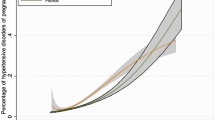Abstract
Purpose
To determine the rate of severe maternal morbidity related to delivery by delivery mode and to assess if the impact of studied risk factors varies by delivery mode.
Methods
A register-based study including all women having singleton delivery in Finland in 2007–2011, n = 292,253, data derived from the Finnish Medical Birth Registry and Hospital Discharge Registry. Diagnoses and interventions indicating a severe maternal complication were searched and the mode of delivery was assessed by data linkage. The impact of obesity, maternal age 35 years or more, pre-eclampsia and insulin dependent diabetes on severe maternal morbidity (all severe complications, severe infections and severe) was studied in each mode of delivery and calculated as Odds ratios.
Results
The overall incidence of severe complications was 12.8/1,000 deliveries. The total complication rate was lowest in vaginal deliveries (VD) in all risk groups. Obesity increased the risk for all severe complications and severe infections in the total population, but not significantly in specific delivery modes. Age increased the risk of hemorrhage in VD. Pre-eclampsia increased the risk for hemorrhage in all deliveries except elective CS. In women with pre-eclampsia, overall morbidity was similar in VD, attempted VD and elective CS. The presence of any studied risk factor increased the risk for complications within the risk groups by the high proportion of emergency CS performed.
Conclusions
An attempt of VD is the safest way to deliver even for high-risk women with the exception of women with pre-eclampsia, who had a similar risk in an attempt of VD and elective CS.
Similar content being viewed by others
References
Kuklina E, Meikle S, Jamieson D, Whiteman M, Barfield W, Hillis S, Posner S (2009) Severe obstetric morbidity in the United States: 1998–2005. Obstet Gynecol 113(2Pt1):293–299
Schutte JM, Steegers EA, Schuitemaker NW, Santema JG, de Boer K, Pel M et al (2010) Rise in maternal mortality in the Neatherlands. BJOG 117(4):399–406
Pallasmaa N, Ekblad U, Gissler M (2008) Severe maternal morbidity and the mode of delivery. AOGS 87:662–668
Zwart JJ, Richters JM, Öry F, de Vries JIP, Bloemenkamp KWM, van Roosmalen J (2008) Severe maternal morbidity during pregnancy, delivery and puerperium in the Netherlands: a nationwide population-based study of 371,000 pregnancies. BJOG 115(7):842–850
Liston WA (2003) Rising caesarean section rates: can evolution and ecology explain some of the difficulties of modern childbirth? J R Soc Med 96(11):559–561
Liu S, Liston RM, Heaman M, Sauve R, Kramer MS (2007) Maternal mortality and severe morbidity associated with low-risk planned caesarean delivery versus planned vaginal delivery at term. CMAJ 176(4):455–460
van Dillen J, Zwart JJ, Schutte J, Bloemenkamp KWM, van Roosmalen J (2010) Severe acute maternal morbidity and mode of delivery in the Netherlands. AOGS 89:1460–1465
Pallasmaa N, Ekblad U, Aitokallio-Tallberg A, Uotila J, Raudaskoski T, Ulander V-M et al (2010) Cesarean delivery in Finland: maternal complications and obstetric risk factors. Acta Obst Gyn Scand 89:896–902
Waterstone M, Bewley S, Wolfe C (2001) Incidence and predictors of severe obstetric morbidity. BMJ 322(7294):1089–1093
Farchi S, Polo A, Franco F, Di Lallo D, Guasticchi G (2010) Severe postpartum morbidity and mode of delivery: a retrospective cohort study. AOGS 89:1600–1603
van Dillen J, Zwart J, Schutte J, van Roosmalen J (2010) Maternal sepsis: epidemiology, etiology and outcome. Curr Opin Infect Dis 23:249–254
Jarvie E, Ramsay JE (2010) Obstetric management of obesity in pregnancy. Seminars Fetal Neonatal Med 15:83–88
Dinatale A, Ermito S, Fonti I, Giordano R, Cacciatore A, Romano M et al (2010) Obesity and fetal-maternal outcomes. J Prenatal Med 4(1):5–8
Acosta CD, Knight M, Lee HC, Kurinczuk JJ, Gould JB, Lyndon A (2013) The continuum of maternal sepsis severity: incidence and risk factors in a population-based cohort study. PLoS One 8(7):e67175
Fyfe EM, Thompson JM, Anderson NH, Groom KM, McCowan LM (2012) Maternal obesity and postpartum haemorrhage after vaginal and caesarean delivery among nulliparous women at term: a retrospective cohort study. BMC Pregnancy Childbirth 12(1):112
Sebire NJ, Jolly M, Harris JP, Wadsworth J, Joffe M, Beard RW et al (2001) Maternal obesity and pregnancy outcome: a study of 287,213 pregnancies in London. Int J Obes Relat Metab Disord 25(8):1175–1182
Kaisa Raatikainen, Nonna Heiskanen, Seppo Heinonen (2006) Transition from overweight to obesity worsens pregnancy outcome in a BMI-dependent manner. Obesity 14(1):165–171
Acosta CD, Bhattacharya S, Tuffnell D, Kurinczuk JJ, Knight M (2012) Maternal sepsis: a Scottish population-based case control study. BJOG 119(4):474–483
Witteveen T, Zwart JJ, Gast KB, Bloemenkamp KW, van Roosmalen J (2013) Overweight and severe acute maternal morbidity in a low-risk pregnant population in the Netherlands. PLoS One 8(9):e74494
Samuelsson E, Hellgren M, Högberg U (2007) Pregnancy-related deaths to pulmonary embolism in Sweden. AOGS 86:435–443
Temmerman M, Verstraelen H, Martens G, Bekaert A (2004) Delayed childbearing and maternal mortality. Eur J Obstet Gynecol Reprod Biol 114(1):19–22
Eskild A, Vatten LJ (2009) Abnormal bleeding associated with preeclampsia: a population study of 315,085 pregnancies. AOGS 88(2):154–158
Riley LE, Tuomala RE, Heeren T, Greene MF (1996) Low risk of post-cesarean section infection in insulin-requiring diabetic women. Diabetes Care 19(6):597–600
Conflict of interest
We declare that we have no conflict of interest.
Author information
Authors and Affiliations
Corresponding author
Rights and permissions
About this article
Cite this article
Pallasmaa, N., Ekblad, U., Gissler, M. et al. The impact of maternal obesity, age, pre-eclampsia and insulin dependent diabetes on severe maternal morbidity by mode of delivery—a register-based cohort study. Arch Gynecol Obstet 291, 311–318 (2015). https://doi.org/10.1007/s00404-014-3352-z
Received:
Accepted:
Published:
Issue Date:
DOI: https://doi.org/10.1007/s00404-014-3352-z




